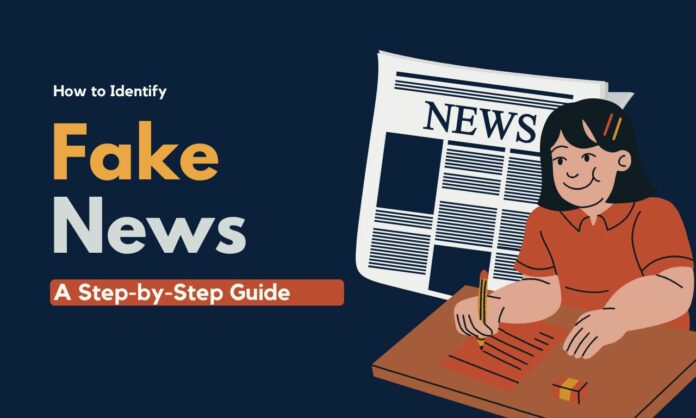Fake news has become a pervasive problem in today’s digital age. Misinformation and disinformation can have serious consequences, from influencing public opinion and political elections to spreading panic and mistrust. This guide provides a detailed, step-by-step approach to help you identify fake news and ensure the information you consume and share is accurate.
Table of Contents
Step 1: Consider the Source
Evaluate the Credibility
- Check the Domain Name: Look for suspicious domain names that mimic legitimate news sources but have subtle differences, such as “.co” instead of “.com” (e.g., abcnews.com.co).
- Investigate the Website: A credible news source will have a professional-looking website. Check for a well-designed layout, correct grammar, and a clear “About Us” section detailing the organization’s mission, editorial standards, and contact information.
- Research the Source: Look up the website or organization on fact-checking sites like Snopes, FactCheck.org, or Media Bias/Fact Check. If the site has a history of publishing false or misleading information, it may not be reliable.
Step 2: Check the Author
Assess the Author’s Credentials
- Author Information: Reliable articles usually include the author’s name and credentials. Be cautious if the article does not list an author.
- Author Background: Search for the author’s other work and professional background. Experienced journalists and writers usually have a portfolio of work and verifiable credentials.
- Social Media Presence: Check if the author has a professional social media presence. Reputable journalists often have verified accounts on platforms like Twitter or LinkedIn.
Step 3: Analyze the Content
Evaluate the Writing Quality
- Grammar and Spelling: Poor grammar and numerous spelling errors can be indicators of a lack of professionalism and credibility.
- Emotional Language: Be wary of articles that use overly sensational or emotional language designed to provoke a strong reaction. Reliable news reports aim to inform, not to incite.
Verify the Information
- Cross-Check Facts: Verify the facts presented in the article by checking other reputable news sources. If the story is legitimate, it will be reported by multiple trusted outlets.
- Look for Supporting Evidence: Reliable articles will cite credible sources and provide evidence to back up their claims. If the article lacks references or links to supporting information, it may be suspect.
- Check the Date: Ensure the article is current. Sometimes, outdated articles are recirculated as new to mislead readers.
Step 4: Examine the Intent
Consider the Purpose
- Editorial Bias: Determine if the article is editorial or opinion-based rather than factual reporting. Opinion pieces often reflect the author’s personal views and can be biased.
- Satire and Parody: Some websites publish satirical or parody content that is not meant to be taken seriously. Verify if the source is known for satire.
Step 5: Check the Images
Assess Visuals for Authenticity
- Reverse Image Search: Use tools like Google Reverse Image Search to check if the images used in the article are authentic or have been taken out of context. Often, fake news articles use misleading images to bolster their claims.
- Photo Manipulation: Look for signs of photo manipulation. Tools like TinEye can help determine the origin of an image and if it has been altered.
Step 6: Read Beyond the Headlines
Investigate the Entire Story
- Misleading Headlines: Fake news often uses sensational headlines to grab attention. Ensure you read the entire article to understand the full context and not just the headline.
- Quotes and Statements: Check if the quotes and statements within the article are accurate and properly attributed to credible sources.
Step 7: Use Fact-Checking Websites
Utilize Professional Fact-Checkers
- Snopes: One of the oldest and most respected fact-checking sites.
- FactCheck.org: A non-partisan, nonprofit organization that monitors the accuracy of U.S. political statements.
- PolitiFact: A website that checks and rates the accuracy of claims made by elected officials and others.
- AFP Fact Check, BBC Reality Check: These international fact-checking services provide global perspectives on misinformation.
Step 8: Develop Critical Thinking Skills
Cultivate Skepticism and Curiosity
- Question Everything: Approach all news with a healthy dose of skepticism. Ask yourself who benefits from the dissemination of the information and why it might be shared.
- Stay Informed: Educate yourself about common misinformation tactics and the ways in which fake news spreads. Understanding the mechanics of fake news can make you more resilient to it.
Step 9: Report Fake News
Take Action Against Misinformation
- Report on Social Media: If you encounter fake news on social media, report it to the platform. Most social media sites have mechanisms to report false information.
- Inform Others: Share your findings with friends and family to help them become more discerning consumers of news.
Conclusion
Identifying fake news requires a combination of vigilance, critical thinking, and the use of reliable resources. By following these steps, you can protect yourself and others from the harmful effects of misinformation. Always remember, being informed is not just about consuming information, but about verifying its accuracy and integrity.
